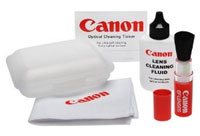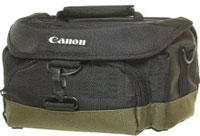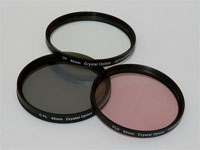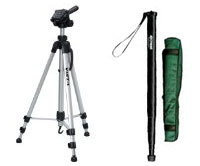Tips and Tricks: Gifts
Photography Gifts
Cleaning Kits
section of any department store near the car waxes and are quite cheap. Compact digital
cameras usually require less invasive cleaning than their SLR counterparts.
From an SLR perspective there are more places in which to clean from the removable lenses themselves to the body of the camera. While some are scared to clean the internals of a SLR, as they assume there are exposed sensors, this is not necessarily the case. Along with similar products to those mentioned above, look for kits which contain longer cleaning swabs and even compressed air blowers. Caution should be heeded if you try and use a product with a compressed air cartridge as some of these, like the compressed air cans you can purchase for blowing out keyboards, will actually spray contaminants as they utilize liquid propellants. Even some products made specially for this purpose have been reported to occacionally have this issue so caution is advised.
Before purchasing cleaning kits you should always consult the camera manufacturers manual, visit their website or send them an email first as they should have recommendations as to what should be used.
Cases, Bags and Organizers
expect much from
these as most are not designed to house and store accessories. Some have
belt loop attachments for travel and others are just simple cases. They
all provide basic protection for carrying around small cameras. A
real cheap solution for basic protection is a cheap cigarette soft-case which
works quite well and offers easy access to the camera when
you need it. These can be found at convenience stores, pharmacies or
department stores for less than $2.
For more portability options you could look into hip packs. Hip packs work well with compact digital cameras as they can easily be worn on a belt or carried around quite easily while offering some padded protection. Small hip packs have compartments for storing additional memory cards, batteries, cleaning tools and other multi-purpose requirements. Some medium-sized camera bags are also advertised as hip bags and can store quite a bit of accessories or can be utilized for SLR's. These usually are too large for me to really put in the hip-bag range as they can be quite bulky and are more in the shoulder bag size. Regardless, hip bags range in price from $15 to over $70 dependant on size and versatility.
Shoulder/carry bags and backpacks are the next step up in the chain. These come in a multitude of sizes with prices ranging from $15 and up and can be utilized as organizers as well. Most have protected pockets or sections to hold batteries, memory cards, lenses, lens filters, power supplies or just about anything else you may need. These are great for vacations where there may be a need for a number of accessories and will easily work as a carry-on bag for flights. I personally use these to carry my gear on trips but prefer to hip bags for daily use with my SLR or smaller travel cases for my compact digital camera.
Lens Filters
Basic filter kits come with at least a Circular Polarizer (C PL), UV filter (UV) and a Flourescent filter (FL D). The polarizer is used in outdoor photography to deepen the intensity of blue skies and reduce or eliminate glare. UV filters absorb ultraviolet rays and give cleaner, sharper pictures that can have less haze. Flourescent filters are used when fluorescent lighting is the primary light source as these filters can change the greenish color that fluorescent lights cause into a more natural light.
Larger filter kits will add Natural Density (ND) filters which help eliminate overly bright and washed out images. Macro Filters which magnify subjets if macro-photography is your thing. There are also warming and cooling filters which can enhance blues or reds.
It is always wise to purchase kits which are for the camera lenses you are utilizing to ensure they fit properly. Never fear, if the size is not quite correct there are step-up and step-down adapter rings available.
Basic lense filter kits start as low as $14. As with everything, the higher the quality the more expensive they become.
Tripods and Monopods
Use? Tripods come in multiple sizes which range from small miniature tripods ($5 and up) to full-sized which start from $15 up. Be wary of the small miniature tripods if you are using SLR's as they may not be able to hold the weight. Monopods have a telescoping leg with a point at one end and a screw for the camera at the other.
Cleaning Kits
 |
Cleaning kits can be found in all sizes with and accesories for as low as $5. Basic kits come with a couple of small micro fiber cloths, lense cleaner, a small brush and a spray bottle or bulb to blow away dust. Larger kits add swabs, LCD screen cleaner, and travel cases. I also find it handy to keep a couple of larger micro fibre cloths handy to wipe down the camera body as well and these may be found in the automotive |
From an SLR perspective there are more places in which to clean from the removable lenses themselves to the body of the camera. While some are scared to clean the internals of a SLR, as they assume there are exposed sensors, this is not necessarily the case. Along with similar products to those mentioned above, look for kits which contain longer cleaning swabs and even compressed air blowers. Caution should be heeded if you try and use a product with a compressed air cartridge as some of these, like the compressed air cans you can purchase for blowing out keyboards, will actually spray contaminants as they utilize liquid propellants. Even some products made specially for this purpose have been reported to occacionally have this issue so caution is advised.
Before purchasing cleaning kits you should always consult the camera manufacturers manual, visit their website or send them an email first as they should have recommendations as to what should be used.
Cases, Bags and Organizers
 |
As time passes, photographers start getting more and more parts and
accessories for their cameras. Since cameras don't come with organizers,
these make a great gift. For those who use pocket-sized digital cameras
a small case may be preferred to keep it portable while protecting the
LCD, lense and body.
Small travel cases can be found for as low as $4. Don't |
For more portability options you could look into hip packs. Hip packs work well with compact digital cameras as they can easily be worn on a belt or carried around quite easily while offering some padded protection. Small hip packs have compartments for storing additional memory cards, batteries, cleaning tools and other multi-purpose requirements. Some medium-sized camera bags are also advertised as hip bags and can store quite a bit of accessories or can be utilized for SLR's. These usually are too large for me to really put in the hip-bag range as they can be quite bulky and are more in the shoulder bag size. Regardless, hip bags range in price from $15 to over $70 dependant on size and versatility.
Shoulder/carry bags and backpacks are the next step up in the chain. These come in a multitude of sizes with prices ranging from $15 and up and can be utilized as organizers as well. Most have protected pockets or sections to hold batteries, memory cards, lenses, lens filters, power supplies or just about anything else you may need. These are great for vacations where there may be a need for a number of accessories and will easily work as a carry-on bag for flights. I personally use these to carry my gear on trips but prefer to hip bags for daily use with my SLR or smaller travel cases for my compact digital camera.
Lens Filters
 |
Those who are new to SLR's can always use a good set of lense filters.
For auto-focus cameras, like most SLR's the general public would use,
circular polarizer lenses are used to make subtle changes to the images and,
at times, pictures can't be taken without them.
Lense filters are designed to screw into the end of the camera lense and can also be used as a protective surface to the more expensive lense itself. |
Basic filter kits come with at least a Circular Polarizer (C PL), UV filter (UV) and a Flourescent filter (FL D). The polarizer is used in outdoor photography to deepen the intensity of blue skies and reduce or eliminate glare. UV filters absorb ultraviolet rays and give cleaner, sharper pictures that can have less haze. Flourescent filters are used when fluorescent lighting is the primary light source as these filters can change the greenish color that fluorescent lights cause into a more natural light.
Larger filter kits will add Natural Density (ND) filters which help eliminate overly bright and washed out images. Macro Filters which magnify subjets if macro-photography is your thing. There are also warming and cooling filters which can enhance blues or reds.
It is always wise to purchase kits which are for the camera lenses you are utilizing to ensure they fit properly. Never fear, if the size is not quite correct there are step-up and step-down adapter rings available.
Basic lense filter kits start as low as $14. As with everything, the higher the quality the more expensive they become.
Tripods and Monopods
 |
Tripods or monopods can be quite handy when stability is a requirement. A tripod is a 3-legged camera stand of various designs and sizes. A monopod is a single-legged camera support. You would use a tripod to fully support your camera whereas a monopod, having only a single leg, is simply there to help stabilize a picture while you are holding the camera. Which one to choose depends on what you think it can be used for. If the photographer is constantly on the move then a monopod would do. If they need a setup where the camera location won't change often then a tripod would possibly be best. |
Use? Tripods come in multiple sizes which range from small miniature tripods ($5 and up) to full-sized which start from $15 up. Be wary of the small miniature tripods if you are using SLR's as they may not be able to hold the weight. Monopods have a telescoping leg with a point at one end and a screw for the camera at the other.